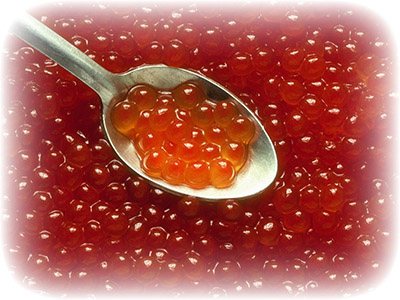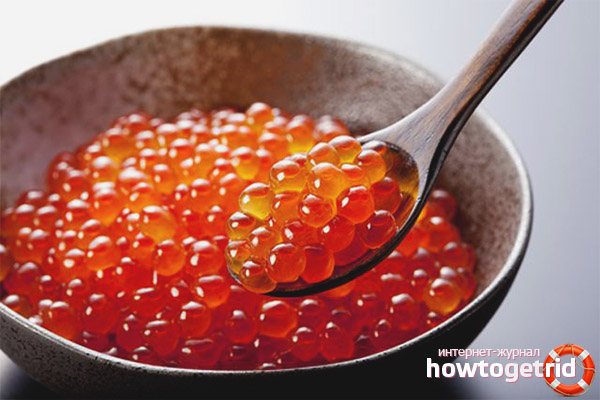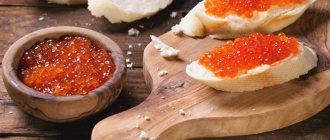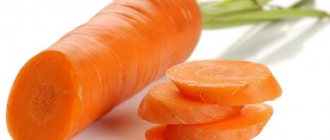Beneficial properties for mother and baby
All seafood is rich in amino acids, iodine, polyunsaturated fats, and a wide range of vitamins and microelements. Red and black caviar contains a large number of useful substances, which can cause, for example, an allergic reaction. Its use during breastfeeding should be moderate. The main components of caviar are:
- Vitamins A, E, D, which improve vision, normalize metabolism, and strengthen the skeletal system.
- Folic acid promotes the formation of blood cells. It produces a large amount of energy and serotonin - the hormone of happiness.
- Iodine plays a vital role in the healthy functioning of the thyroid gland. This is especially important for a nursing mother. Indeed, during pregnancy, under the influence of hormones, its functions may be disrupted.
- Phosphorus, which helps the body absorb glucose, strengthens bones.
- Potassium supports the cardiovascular system and water-salt balance.
- With the help of iron, hemoglobin and the body's protective functions increase.
In addition to all of the above, eating caviar and red fish during lactation will help reduce cholesterol levels and help cleanse harmful substances, improve blood circulation, speed up the process of tissue regeneration, leading to rejuvenation of the entire body. By adding red or black caviar to the diet, it will be easier for a nursing mother to get back into shape. This seafood is high in calories - 100 g of product contains 250 kcal, which casts doubt on whether a nursing mother can eat red caviar. But given that much less product is consumed at a time, you should not worry about oversaturation. On the contrary, it only leads to the body being filled with energy. Even after eating red caviar during breastfeeding in the amount of 1/2 tsp, mommy will gain strength for the whole day. Along with the question of the benefits for the mother, it is important to decide whether children can have red caviar, since a fragile body can unexpectedly react to even 2 eggs: a newborn baby may have an allergic rash as a result of problems with the intestines or a reaction to the components. If nothing bad happened to the baby after eating caviar, we can only talk about the benefits.
Opinions from breastfeeding experts
By the baby's behavior and appearance, you can determine whether breast milk is enough for him, how nutritious and healthy it is. If the baby is lethargic and is not gaining weight well, the pediatrician will pay attention to this and advise the mother to make adjustments to the diet. Therefore, before adding red caviar to your food, it is recommended to discuss this issue with your pediatrician. Most experts agree that you should not rush to introduce this delicacy into your diet because of its ability to cause persistent allergies.
If a nursing mother experiences anemia or loss of strength, she can sometimes consume red caviar in small quantities. But at the same time you will need to look at the child’s reaction. The canned product contains excess table salt. It is prohibited for nursing mothers suffering from edema, because this product retains fluid in the body. Because of this, women with kidney disease should not consume red caviar. Fresh will not harm your health. On the contrary, before the stage of canning and processing with table salt, it contains all the beneficial substances listed above. Negative consequences arise precisely from the industrially processed product. Therefore, doctors do not recommend eating red caviar during breastfeeding.
We reveal the question: Basic positions and rules for feeding a newborn baby
Red caviar and contraindications
Despite all the good things, one should also take into account the harm of the red color of caviar due to its rich composition. It is necessary to carefully study all the negative consequences in order to finally decide whether nursing mothers can eat seafood, and what consequences may occur for the baby. Caviar is a strong allergen. Its use can affect the health of the newborn, so after the first meal you should carefully monitor the baby’s reaction. Do not forget that caviar is salted, which can affect the taste of the milk. The child may not like such a change, and then he will refuse the breast. There is one more danger - the presence of pathogenic microorganisms and even worms in the eggs, which settle in the body of a nursing mother and can lead to dire consequences, even severe intoxication. Therefore, it is better to think carefully about whether it is worth eating such a product during breastfeeding. There are a number of contraindications for using the product:
- tendency to swelling (salt retains water in the body, thereby aggravating the situation);
- kidney diseases;
- individual intolerance or allergic reaction to caviar.
Reasons for not eating red caviar
The amount of red caviar, which will not harm the body of an adult, is 4-5 teaspoons. A nursing mother, who cares about the health of her baby, follows a diet without allowing herself excesses in the form of chocolate cake or smoked sausage. She wants to diversify her taste sensations, she buys a jar of red caviar and eats it all. As a result, instead of benefit, she will, at a minimum, receive fluid retention in the body, which will provoke the occurrence of edema. Therefore, it is important to dose the intake, especially during breastfeeding.
Let's explore the question: Can a mother eat pumpkin while breastfeeding?

The negative point is the ability of caviar to provoke food allergies. Fish products are famous for their high allergenicity. Moreover, the mother may not have an allergy, but the child, whose body gradually gets used to new products, can react negatively to caviar. Another disadvantage: eating the delicacy will give breast milk a salty taste. This will affect the baby's eating habits. He will get used to the presence of salt in the milk, and when the mother stops eating red caviar, the previous taste of the milk will be restored, but the child will no longer want it. It also happens with adults: without salt, food will seem bland.
How to introduce it into the diet?
Red and black caviar are considered a delicacy. This means consuming it in small quantities. Red caviar is administered especially carefully during breastfeeding in order to maximally eliminate negative consequences for both mother and child. Pediatricians recommend introducing it into your diet after the baby is six months old. You need to start with a few grains. If everything went well, you can gradually increase the amount every other day to several grams, i.e. 1 small piece of bread with caviar 3 times a week. In case of allergies, colic and abdominal pain, you should stop eating caviar for a while or refuse completely. The main rule of nutrition is that everything is good in moderation. It is necessary to understand that if mothers eat caviar with spoons, this can cause negative consequences.
Table of substance contents and nutritional value of red caviar
| Name | Content per 100 g | % Daily Value |
| Fats | 17.9 g | 32 |
| Squirrels | 24.6 g | 53,5 |
| Carbohydrates | 4 g | 1,6 |
| Vitamin A | 271 mcg | 30,1 |
| Vitamin B1 | 0.19 mg | 12,7 |
| Vitamin B2 | 0.62 mg | 34,4 |
| Vitamin B5 | 3.5 mg | 70 |
| Vitamin B6 | 0.32 mg | 16 |
| Vitamin B9 | 50 mcg | 12,5 |
| Vitamin B12 (cobalamins) | 20 mcg | 667 |
| Vitamin E | 1.89 mg | 12,6 |
| Vitamin PP | 0.12 mg | 0,6 |
| Vitamin D | 0.172 mcg | 1,7 |
| Vitamin K | 0.6 mcg | 0,5 |
| Calcium | 143 mg | 14,3 |
| Magnesium | 14 mg | 3,5 |
| Sodium | 47 mg | 3,6 |
| Potassium | 145 mg | 5,8 |
| Phosphorus | 89 mg | 11,1 |
| Chlorine | 35 mg | 1,5 |
| Sulfur | 30 mg | 3 |
| Iron | 0.01 mg | 0,1 |
| Iodine | 2 mcg | 1,3 |
| Copper | 20 mcg | 2 |
| Manganese | 0.017 mg | 0,9 |
| Molybdenum | 7 mcg | 10 |
When can you have red caviar during breastfeeding?
As a rule, doctors do not recommend delicacies during breastfeeding. However, an exception is sometimes made for red caviar. Mainly because it is extremely beneficial for both mother and child.
You can find out what foods increase lactation in our article. Read here what fruits a nursing mother can eat.
Is it possible to eat oatmeal cookies while breastfeeding, read the link
So, you can introduce red caviar into your diet as follows:
- First of all, the child must be at least 4 months old. And then only if the child is completely healthy and does not have a tendency to allergies;
- At first, you need to carefully monitor your breasts, trying to detect possible allergic reactions. If there were no allergies during the first two days, but problems appeared in the intestines (colic, diarrhea, constipation, gas formation, etc.), red caviar should also be excluded;
- You should start with a few eggs for breakfast (no more than 0.5 tsp);
- In the absence of any reactions, the daily portion can be expanded to 10-15 grams;
- Daily consumption of red caviar is not recommended. It is optimal to eat it once or twice a week. With this intake, the body will be supplied with the necessary amount of useful substances;
- It should be understood that foods must be introduced into the diet one at a time. That is, if you introduce red caviar, all other products should already be familiar to the child;
- If a nursing mother decides to eat red caviar, it should be natural and high quality.
Remember - the absence of an allergy in a child does not mean that the body digests this product without problems. It may well be that he is working at maximum capacity. Such a load on a young body is not what is needed. Therefore, you should not rush to introduce such delicacies into your diet.
The most common way to consume this seafood is sandwiches. Nursing mothers are also allowed to eat sandwiches. You can even lightly spread butter on them. Tartlets with caviar are also gaining wide popularity.
Essentially, they are the same sandwich, only smaller. This snack contains much less carbohydrates. You can also add caviar to salads or sauces as a decorative element.
How to choose?
During breastfeeding, it is important to monitor the quality of foods consumed. Due to the high cost and positioning of the product, there are the largest number of fake caviar on the market, and you need to know exactly how to choose the right high-quality and healthy product. There are 3 types of caviar on our shelves:
- chum salmon (large, orange with red splashes);
- pink salmon (medium, bright orange);
- sockeye salmon (small in size, dark red with a pronounced smell and taste).
High-quality red caviar is packaged in glass jars. This not only allows the original freshness to be preserved, but also allows the buyer to consider the contents during the selection process. All eggs in the jar must be smooth, uniform, whole, without cloudy sediment. It is necessary to take into account the storage conditions of the product at the point of sale; the temperature in refrigerators should not exceed −5°C, otherwise it is better to refuse the purchase. Price should also be an important aspect of the choice. The composition of the delicacy determines its high cost, and if you add to this packaging, containers with a yoke lock, etc., the cost of the caviar itself will be inflated.
How to choose
To choose a quality product, consider the following recommendations:

- Buy red caviar from specialized sales outlets that can provide the required temperature conditions for storage.
- A high-quality product is packaged in glass or tin containers. Selling in a plastic bag or plastic box indicates a low-quality product.
- Be sure to have a final expiration date stamped on the bottom of the jar.
- Check for clear labeling indicating the manufacturer, its address and contact details.
- Read the ingredients carefully. The content of preservatives and additives is unacceptable.
- Oily and greasy streaks on the can indicate a violation of the integrity of the container. This product should not be purchased.
- Don't buy a cheap product. Red caviar is considered a delicacy, and its quality representative has a significant cost.
Never consume a product if there is any doubt about its quality and freshness. The consequences can be unpredictable for the child and his mother.
Is it possible to have pea soup while breastfeeding?
How to store?
Storing red caviar after opening the jar is subject to clear rules, deviating from which the product can spoil the very next day. First of all, if the jar in which the caviar was sold was metal, you must immediately transfer it into a glass container with a tight-fitting lid. Before placing the delicacy in a container, it should be steamed with boiling water and allowed to cool. It is best not to expose this delicacy to long-term storage after the seal has been broken. But if a small amount of caviar remains, you need to cover it with lemon slices and sprinkle with a few drops of vegetable or olive oil. This way you can extend the shelf life up to 5 days. The delicacy can be stored at an optimal temperature of −5°C, so in the refrigerator you need to place the jar on the lowest shelf closer to the back wall. Long-term storage after freezing in the refrigerator is allowed. In advance, the caviar is packaged into portions, placed in jars and covered with lids. The shelf life when frozen is about a year. To defrost a product, it should first be placed in the general compartment of the refrigerator in order to preserve as many useful properties as possible.











